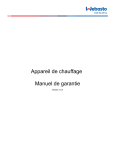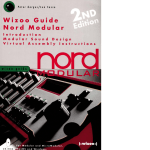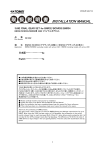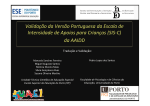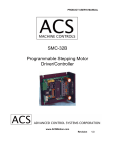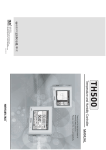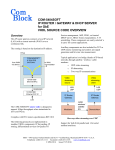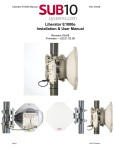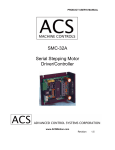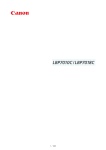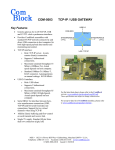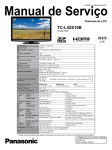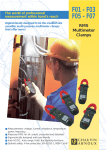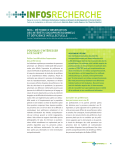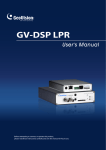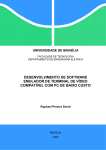Download USER`S MANUAL - Advanced Control Systems
Transcript
USER’S MANUAL MCU-1 / MCU-2 STEPPING MOTOR CONTROLLERS REVISION 1.1 35 Corporate Park Drive, Pembroke, Massachusetts 02359 PHONE: 781-829-9228 FAX: 781-829-9875 EMAIL: [email protected] www.ACSMotion.com 2 Advanced Control Systems MCU-2 3 Advanced Control Systems MCU-2 TABLE OF CONTENTS GENERAL NOTICES Warranty Assistance and Maintenance Agreements Documentation and Discrepancies Service Procedure SECTION 1 1.1 1.2 1.3 1.4 1.5 1.6 1.7 1.8 1.9 1.10 SECTION 2 2.1 2.2 2.3 2.4 2.5 2.6 MCU-2 INSTRUCTION SET Instruction Set abbreviations and Notes Data Enter Instructions Data Examine Instructions Motion Execute Instructions Instruction Set, Specifics and Examples SECTION 4 4.1 4.2 4.3 INSTALLATION AND INTERCONNECTIONS MCU-2 Motor Operation Internal Settings Motor Connections Power Connections Encoder/Limits Connections Communication Ports Connections SECTION 3 3.1 3.2 3.3 3.4 3.5 GENERAL INFORMATION Safety Features of the Unit Controls and Instructions Displays and Connectors Communication Standards Moving Elements: Motors and Encoders Power Plan Dimensions and Mounting Motion Systems Overview Controller/Driver Design APPLICATION NOTES Motor Current Adjustments Manual Mode of Operation Automatic Mode of Operation 4 Advanced Control Systems MCU-2 SECTION 1 1.1 GENERAL INFORMATION Safety “The use of electric motors and generators, like that of all other utilization of concentrated power, is potentially hazardous. The degree of hazard can be greatly reduced by proper design, selection, installation, and use, but hazards cannot be completely eliminated. The reduction of hazard is the joint responsibility of the user, the manufacturer of the driven or driving equipment, and the manufacturer of the motor or generator.” Standards Publication No. ANSI-C51-1/NEMA MG-2 “Safety Standard for Construction and Guide for Selection, Installation, and Use of Electric Motors and Generators”. Available From: National Electrical Manufacturer’s Association 2101 L Street N. W. Washington, DC 20037 This manual should be completely read and understood prior to installing, operating, or troubleshooting the MCU-2. Observe all federal, state, and local safety standards that are pertinent to this piece of equipment. 5 Advanced Control Systems MCU-2 1.2 MCU-2 Features • The MCU-2 drives two four-phase motors, providing two motion stepping axes. The MCU-1 drives one motor. • A proven design in the critical translator stage provides high power and high speed using conservative industrial voltages and other motor power supply characteristics. • Available stepping rates are up to 40,000 (half) steps per second (eight-step input sequence, also called half-step mode) use the full mechanical speed range of the motors. • Programmable reduction of stepping rates by factor of ten. • No dropping resistors are used, meaning that there are no resistors in motor circuits. All necessary tuning of the unit/motor system is done with screwdriver-actuated adjustments of the unit. • Communication is by serial link, which provides great flexibility in system architecture. Electrical standards are RS-232C and RS-485. • If an incremental encoder is used on a motion stepping axis, the MCU-2 will decode the signals from the encoder to provide position information. • MCU-2 performs indexing functions without depending on a host computer. This means that an axis can be driven a specified distance, starting at a specified base speed, accelerating to and decelerating from a specified top speed at a specified ramp, and stopping from the base speed. This substantially frees the host computer. • In addition to stopping stepping of a motion axis upon closure of a limit switch, the MCU-2 responds to inquiries from the host computer as to the status, open or closed, of either of the limit switches or the home position switch. • Each axis has an address with the number of available addresses allowing up to 100 motors to be controlled from a single host computer serial port. • On instruction the unit will store data entered in a nonvolatile memory which retains the information even when the supply voltage to the control/drive is removed. • Basic MCU-2 versions have a position display for each axis consisting of seven digits and sign, in conjunction with a conversion constant 6 Advanced Control Systems MCU-2 communicated from the host computer. Position is shown in large, bright numerals in engineering units. • Basic MCU-2 versions have a three-position mode switch and just five springloaded push-button switches, for each axis. With speed rates and acceleration/deceleration ramp factors communicated from the host computer the manual controls can be simple and comfortable for the operator and appropriate to the physics of the equipment. • MCU-1 is the basic versions of the single axis unit. 7 Advanced Control Systems MCU-2 1.3 Controls and Instructions The MCU-2 operates in one of three modes, automatic, manual, and motor current off, depending on the setting of the switch on the front panel. In the manual slew mode push-buttons on the front panel set the position display to zero and slew and jog at the entered rates in positive or negative directions. (Thus there are five (5) push-button controls for each axis). If no value has been entered for any or all of the numeric values needed, jog or slew rate or ramp factor, including the case where the unit has never been connected to at host computer, the default values will be uses. Thus the MCU-2 can actually operate usefully without a host computer, although normally we think of the unit as a computer peripheral. The mode causing motor current to be turned off removes power from the motor windings, thus removing torque except for a small value of residual motor torque. In the automatic mode the MCU-2 follows the instructions of a host computer. The unit has such computing power, or intelligence, however, that depending on the physics of the equipment, characteristics of the motors, (and encoders, if used), instructions chosen by the programmer, and the supervisory program executed by the host computer, very few instructions from the host to controller/driver may be required. This affects the amount of time the host must devote to developing and transmitting instructions for a motion stepping axis, the other functions performed by the supervisory program of the host, and the number of MCU-2 control/drive units that can be supervised by a host. An instruction is a character or group of characters that will be interpreted by the unit as a command. An instruction is formatted as follows: Start Character Axis Address/Instruction Mnemonic/Parameter/Terminator Example: #12G02 Axis with address 2 will index the motor to next position, using parameter locations 02. “↵“ is an instruction terminator. Start Character: All messages generated by the host computer must start with ASCII # character. Axis Address: A decimal from “00” to “99” and “**”. If not a valid address, the instruction will be ignored. “**” is an “ALL” or Global axis address. “*” can replace any address decimal digit. 8 Advanced Control Systems MCU-2 Instruction Mnemonic: Consists of on to tow non-numeric characters from the list of commands. If not of this list the unit will ignore the instruction. Parameter: Not required for all instructions. Must be numeric. Length depends on instruction. Terminator: Carriage Return character, a non-printing character, terminates all commands. An instruction is communicated to the unit. When a terminator is received by the unit, the unit communicates its response. An important aspect of operation is the fact that a conversion constant can be entered which allows use of measuring (engineering) units instead of motor steps to be displayed. The conversion constant is that number of motor steps which constitutes one measuring unit of position. The default value of this parameter is 1. 9 Advanced Control Systems MCU-2 1.4 Displays and Connectors Basic versions display the position of each axis on the front panel as a signed seven digit decimal number with decimal point floating. Light emitting diodes immediately to the left of the sign indicate closure of limit switches or the home position switch. Among the data to be entered via communication link with the host computer is that conversion constant which will result in position being displayed in the measuring units of interest rather than in motor steps. The height of each digit is 0.56 inches and the color of the display is red. All units have a back panel on which are located connectors designed for multiple or repeated use. These connectors are of different types, depending on the kind of signal or power involved and safety considerations. Motor Connectors - are round, mechanically shielded, 6 pins. RS-232 Connector - is D-type, electrically shielded, 25 pins. RS-485 Connector - is flat cable type, 10 pins. Encoder and Switch Connectors - are flat cable type, 10 pins. Motor Power (Input/Supply) Connector - is a barrier terminal block, 3 terminals. 115 VAC Inlet Connector - is three-pronged, mechanically shielded. In addition basic units have a 115 VAC outlet connector which is three-pronged, mechanically shielded. Power to this connector is on when the front panel switch is on. Again, excepting certain OEM versions, all units have convenient controls for configuring the unit to a particular equipment arrangement, a task that may have to be done more than once, but is not done repeatedly. These controls are all screwdriver-actuated. Communication Mode Switch- detent -type, 16 position Axis Address Switch - detent - type, 16 position Motor Torque Potentiometers - with locking nuts 10 Advanced Control Systems MCU-2 1.5 Communication Standards The unit communicates with a host computer by ASCII codes transmitted in bitserial fashion over a single transmission line. The rates at which data can be transmitted and received, in bits per second are: COMMUNICATION MODE SWITCH SETTING BAUD RATE 0 1 2 3 4 5 6 7 8 9 10 11 12 13 14 15 300 Parity Ignored 600 “ “ 1200 “ “ 2400 “ “ 4800 “ “ 9600 “ “ 19,200 “ “ Spare 300 Parity Programmed 600 “ “ 1200 “ “ 2400 “ “ 4800 “ “ 9600 “ “ 19,200 “ “ Spare Each ASCII code is transmitted by sending a start bit, eight data bits, and a stop bit. This means each code in transmission is ten bits. Parity can be preprogrammed to be even, odd, or ignored. 11 Advanced Control Systems MCU-2 1.6 Moving Elements: Motors and Encoders The fundamental motor specification is that of a four phase DC stepping motor with six or eight leads and a rated phase current of six amperes or less. This is the type of digital motor found in commercial applications. The encoder specification is for a dual channel pulse output incremental encoder with output signal phased in quadrature and a signed level of 5 volts (TTL, Transistor-Transistor Logic). This is the kind of encoder used for digitizing motion in commercial applications. In the architecture of a motion system, an address must be assigned to each motion axis. The following table relates the back panel axis address switch to the logical address used for communication. Address Switch Setting 0 1 2 3 4 5 6 7 8 9 10 11 12 13 14 15 Address 00 or Preprogrammed for any value up to 99 01 02 03 04 05 06 07 08 09 10 11 12 13 14 15 12 Advanced Control Systems MCU-2 1.7 Power Plan The requirements of the controller/driver are separated from the requirements of the motor to provide isolation of electrical noise, allow easy integration of heavy components into equipment and permit tailoring of electrical and mechanical arrangements. The unit requires 115 VAC power at 60 Hz. drawing up to 1.0 ampere. This supplies the needs of displays, logic, communications and encoders. Motor power consists of unregulated DC in two voltage ranges, 10 to 15 and 36 to 42. Current draw can be up to 24 amperes, depending on the motors used. The motor power source should be able to supply and accept high current surges. A 10,000 microfarad capacitor connected across each of the two voltages is adequate. Back panel potentiometers are used to adjust motor torque, after which they are locked. Each motion axis has two torque potentiometers, one marked HI(gh), the other LO(w). High (voltage) (pulse width) torque, or high speed torque, or torque at speed, is the adjustment for smooth operation of the motor at the (highest) speed required under equipment operating conditions. This adjustment is at its minimum when the potentiometer is fully counterclockwise, and at is maximum in the fully clockwise position. Motor temperature is directly affected by this adjustment. Low (voltage) (current switching duty cycle) torque, or holding torque, is the adjustment for rated (idle) current in the motor winding when at standstill or zero speed. This adjustment is at its minimum when the potentiometer is fully counterclockwise, and at its maximum in the fully clockwise position. Motor temperature is directly affected by this adjustment. 13 Advanced Control Systems MCU-2 1.8 Dimensions and Mounting Dimensions and weight of basic versions are: Width Over Heat Sink Depth Behind Front Panel Height Depth Overall (Over Handles) Weight 17.1 inches 13.0 inches 3.5 inches 14.6 inches 12 pounds Basic versions have a front panel designed to allow the MCU-2 to be mounted on a standard 19 inch rack. In addition, the front panel has two handles mounted on it to make movement between locations easy. OEM versions can be mounted in a wide variety of ways. 14 Advanced Control Systems MCU-2 1.9 Motion Systems Overview The motion requirements of a machine are considered to form a system, distinct from other systems within the machine. With the other systems the motion system is directed by a computer of some kind. In relation to this computer the motion system is subordinate, the relationship being that of a “master” and “slave” or “host” can “guest”, hence the general use of the term host computer. As a motion stepping package, the controller/driver is a key element in a motion system. It performs several functions: 1. Receiving information from various sources. 2. Performing motion function on command. 3. Controlling “un-phased” power to the motor, which exerts a holding torque at standstill or zero speed. 4. Transmitting stored information in various ways. All of these functions have a discreet nature to them leading to the consideration of time throughout the controller/driver. This is a consideration throughout an entire machine. Each element of each system must be reviewed, at least, briefly, to make sure that the speed with which it operates is consistent with the speed of neighboring elements and the work performed by the machine. 15 Advanced Control Systems MCU-2 1.10 Controller/Driver Design A useful element with which to begin might be that of position. As a motion stepping package, the unit must keep track of the position of moving element(s). It does this with a counter for each axis which has a range of +8,388,606. This counter is driven up and down by signals from either of two sources. If the motion system is equipped with an encoder, the signals from the device are counted. If no encoder is used, signals are taken from the step control section of the unit itself. If an encoder is used, its signals are decoded, then sent to the counter. Connected to the counter, on basic versions, is the position display. Control of the movement of the electrical motor lies in a step control section which emits a signal indicating clockwise or counterclockwise rotation and a pulse of proper duration, voltage and rise and fall time to actuate the driver. The number of pulses and interval between each of them determine the distance of movement of the load and its speed at all times while moving. The step control also controls the state of holding of idle current when the motor is at standstill or zero speed. Pulses from the step control are counted for position display if no encoder is used. Power to the motor is modulated by an electronic drive which translates the information received from the step control into electric power for an electromagnetic-mechanical device, the motor. The MCU-2 uses a proven bi-level design which operates on conservative voltages, appropriate to commercial machinery and provides excellent overall performance. Storage of variables without depending on power is done by a nonvolatile memory under the direct control of the central processor. 16 Advanced Control Systems MCU-2 SECTION 2 2.1 INSTALLATION AND INTERCONNECTIONS MCU-2 Motor Operation The MCU-2 Driver/Controller is designed to operate 2 stepping motors. Running only 1 motor can cause damage to the channel not connected to a motor if the channel is powered-up. The board level fuses to the channel not connected to a motor must be manually removed. If you plan to run a single motor with the MCU-2, follow the instructions below. WARNING! DO NOT SUPPLY POWER TO THE MCU-2 DRIVER/CONTROLLER UNTIL THIS PROCESS IS COMPLETE! 1. CONNECT THE MOTOR TO BE DRIVEN TO THE MCU-2 VIA ONE OF THE 2 (TWO) BACK PANEL CONNECTORS. 2. OPEN THE MCU-2 TOP COVER BY REMOVING THE 6 RETAINING SCREWS 3. IDENTIFY THE CCB-5 DRIVER BOARD WIRED TO THE CORRESPONDING MOTOR CONNECTOR 4. REMOVE BOTH TWO (2) FUSES ON THE CCB-5 DRIVER BOARD NOT CONNECTED TO THE STEPPING MOTOR IN STEP 3 ABOVE. 5. REPLACE THE MCU-2 TOP COVER AND INSTALL THE 6 RETAINING SCREWS 6. FOLLOW THE REMAINING INSTALLATION INSTRUCTIONS IN THIS USER’S MANUAL 17 Advanced Control Systems MCU-2 2.2 Internal Settings The MCU-2 is factory preset for the following operating parameters: Operation without encoder Home switch input normally open Limit switches inputs normally closed Refer to table 2.1 for alternate jumper setting. Remove top plate and move jumpers accordingly. See also board pictorial. JUMPER FUNCTION A1 - A2, B1 - B2 A2 - A3, B2 - B3 Encoder Inputs No Encoder Inputs A1 A2 A3 B1 B2 B3 Figure 2.1 Board Pictorial 18 Advanced Control Systems MCU-2 2.3 Motor Connection Motor is to be connected via round motor connector on the back panel. Refer to Fig. 2.2 for pin assignment and proper stepping motor connection. Refer to Motor Manufacturer data sheets for connection lead color codes or use an Ohm meter to determine the required motor lead configuration. S-6S (639) Mating Plug: Cable Clamp: Cable Boot: Amphenol MS3106A 14S-6P (639) Amphenol 97-3057-1007 (639) Amphenol 9779-513-100 A B F C Connector E Motor D Figure 2.2 Motor Connection To MCU-2 Unit 2.4 Power Connections Connect external power supply to motor power terminal block as indicated on the back panel of MCU-2 unit; common ground to “COM”, +12VDC to “LV”, +36VDC to “HV”. Connect power supply line cable to “115 VAC OUT” connector on the back of MCU-2 unit. Use supplied AC power cable to connect MCU-2 to AC line power. 19 Advanced Control Systems MCU-2 2.5 Encoder/Limits Connections When incremental encoder and limit inputs are utilized, connect these devices per Fig. 2.4. Busy Line: TTL Compatible, LO when stepping. MCU-2 Enc./Lim. Connector 1 2 External Inputs Gnd. 3 Busy Input Home 5 Lim - 7 Lim + 9 Ch. A Ch. B +5 VDC NC Gnd Encoder Inputs (Incremental) Figure 2.5 Encoders/Limits/Home/Interconnect 20 Advanced Control Systems MCU-2 2.6 Communication Ports Connections Connect RS-232 Port of MCU-2 (DB25 type connector) to terminal or host computer serial port per connection diagram on Fig. 2.5A or Fig. 2.5B. Pin 5 on MCU-2 is an output. LO on Pin 5 indicates that MCU-2 is ready for new command. MCU-2 (DB25) 2 3 5 7 HOST (DB25) TX RX 3 2 2 3 CTS GND 11 MCU-2 (DB25) 5 7 7 HOST (DB9) TX RX 2 3 CTS GND 5 11 Fig. 2.5A DB25 to DB25 Communication Cable Fig. 2.5B DB25 to DB9 Communication Cable When there is more than one MCU-2 in the system, they must be daisy chained via RS-485 communication ports and only one MCU-2 must be connected via RS-232 communication cable to the host. RS-485 Standard defines drives and receivers for balanced digital multipoint communication system. The configuration of a system normally consists of several drivers, several receivers and terminating resistor. There can be up to 32 Driver/Receiver pairs on a single balanced line. By utilizing line repeaters the system can be expanded even more. RS-485 is compatible with RS422-A. 21 Advanced Control Systems MCU-2 RS-485 Connector 1 2 N.C 3 4 Common Ground 5 6 7 8 9 10 Data Bi-directional/Balanced) Directional Control (Balanced) (Output) 100 Ohm to Gnd. Figure 2.6; RS-485 Pin Assignments 22 Advanced Control Systems MCU-2 SECTION 3 3.1 MCU-2 INSTRUCTION SET Instruction Set Abbreviations and Notes # - Start Character aa - Controller Address: Range 00 to 99. ** is All Address b - Status Indicator: b = 1 Winding Current On b = 0 Winding Current Off c - Conversion Constant; Range 1 to 65535 dd - Data Block Address; Range 00 to 80 k - Ramp Data; Range 1 to 100 (1,000 to 100,000 step/sec²) r - Rate Data 10 to 40,000 steps/sec n - Position or Step Count Data; Range -8,388,606 to +8,388,606 ↵ - Indicates carriage return character bbbbb O.........Motor is at zero speed R.........Motor is ramping S..........Motor is at speed O..........Controller is in OFF mode A..........Controller is in AUTO mode M.........Controller is in MAN mode O...........Positive Direction Limit is not activated +............Positive Direction Limit is activated O..........Home Input is not activated H..........Home Input is activated O...........Negative Direction Limit is not activated - ...........Negative Direction Limit is activated For example: OOAS: Limits and home inputs are not activated, controller is in auto mode, and motor is at speed. MCU-2 does not respond to “All” Address. MCU-2 does not respond to unrecognized addresses. 23 Advanced Control Systems MCU-2 MCU-2 responds with aa? when address is recognized but structure of the instruction is wrong. 3.2 Data Enter Instructions MNEMONIC DESCRIPTION RESPONSE #aaA↵ Accept Data to NVRAM aa↵ #aaB=r↵ Base Rate Enter #aaC=r↵ Conversion Constant Error #aaDdd=+n↵ Distance Data Enter #aaJ=r↵D Jog Rate (Manual) Enter #aaK=1↵;aaK=10↵ Rate Division Constant Enter #aaP=+n↵ Position Enter #aaRdd=k↵ Ramp Data Enter #aaVdd=r↵ Velocity (Rate)Data Enter #aaW=b↵ Winding (Motor) Current On (b=1) on Off (b=0) #aaZ↵ Zero Current Position #aaV00=r↵ Velocity Data for Manual and immediate Slew Enter #aaR00=k↵ Ramp Data for Manual and immediate Slew Enter aa↵ aa↵ aa↵ aa↵ aa↵ aa↵ aa↵ aa↵ aa↵ aa↵ aa↵ aa↵ Unit Configuration Instructions #aaUPE↵ #aaUPO↵ #aaUPN↵ #aaUaa↵ #aaPRES↵ Set Even Parity Set Odd Parity Set No Parity Set Unit Address to aa Preset NVRAM to Default Conditions aa↵ aa↵ aa↵ aa↵ aa↵ 24 Advanced Control Systems MCU-2 3.3 Data Examine Instructions MNEMONIC #aaB↵ #aaC↵ #aaDdd↵ #aaE↵ #aaJ↵ #aaK↵ #aaM↵ #aaP↵ #aaRdd↵ #aaVdd↵ #aaW↵ DESCRIPTION RESPONSE Base Rate Examine aaB=r↵ aaC=c↵ Conversion Constant Examine Distance Data Examine aaDdd=+n↵ aaE=bbb↵ Examine Limits/Home Inputs Jog Rate (Manual) Examine aaJ=r↵ Rate Division Constant Examine aaK=1↵ or aaK=10↵ aaM=bb↵ Motion Status Present Position Examine aaP=+n↵ Ramp Data Examine aaRdd=k↵ Velocity (Rate) Data Examine aaVdd=r↵ Winding (Motor) Current Examine aaW=b↵ Data Block 00: Velocity data for Slew function Ramp Index for Slew function Data Block 01: Default Ramping Index Velocity data for Go function and Index function Ramp Index for Go function and Index function Note: There are 80 data blocks. Each block contains Velocity (top rate), Distance, and Ramp index. All this information is needed for motion execute commands. 25 Advanced Control Systems MCU-2 3.4 Motion Execute Instructions MNEMONIC #aaF↵ RESPONSE DESCRIPTION aa↵ Finish Function MOTOR RESPONSE Motor decelerates to Base Rate and stops. #aaG+n↵aa↵ Go Function Motor moves to +n absolute #aaG-n↵ aa↵ position using rate and ramp data stored in Location 01. #aaGdd↵ aa↵ Go Function Motor moves to next position rate and ramp data stored at Location dd. #aaH+↵ aa↵ Home Function Motor moves at Base Rate to #aaH-↵ aa↵ Home position in positive and negative direction. #aaI+n↵ aa↵ Index Function Motor moves n steps in #aaI-n↵ aa↵ positive or negative using rate and ramp data store at Location 01. #aaIdd↵ aa↵ Index Function Motor moves preset number of steps using data stored at Location dd. #aaL+↵ aa↵ Limit Function Motor moves at base rate to #aaL-↵ aa↵ positive or negative limit switch. #aaQ↵ aa↵ Quit Function Motor stops stepping immediately. #aaS+↵ aa↵ Slew Start Function Motor ramps in selected #aaS-↵ aa↵ direction from Base rate using rate and ramp data stored in Location dd. #aaSdd↵ aa↵ Slew Function Motor ramps to next rate using rate and ramp data stored in Location dd. #aaS+r↵ aa↵ Slew Function Motor ramps in selected #aaS-r↵ aa↵ direction using ramp data stored in Location 00; and for speed using immediate data (provided for instructions). 26 Advanced Control Systems MCU-2 3.5 Instruction Set: A: Accept Data to NVRAM Instruction: Specifics and Examples #03A↵ Response: 03↵ Function: Controller with address set to 03 will copy all data from volatile memory into nonvolatile storage. It responds with 03. Instruction: #*3A↵ No Response Function: data. All Controllers with second address digit equal 3 will memorize Instruction: #0*A↵ Function: All Controllers with first address digit equal 0 will memorize data. NOTE: No * is a global address character and can be used on any instruction. No Response response is generated. B: Base Rate Enter/Examine Instruction: #03B=400↵ Response: 03↵ Function: Controller loads base rate registers with base rate of 400 steps per second, and responds with its own address and carriage return character. NOTE: Base Rate is starting and stopping rate when motor accelerates to or decelerates from higher speeds. Base rate should be set below start/stop rate of motor load combination from accurate positioning. 27 Advanced Control Systems MCU-2 Instruction: #03B↵ Response: Function: Examination of base rate; base rate is 400 steps/sec. 3.5 Instruction Set: C: Conversion Constant Enter/Examine 03↵ Specifics and Examples Instruction: #03C=200↵ Response: 03↵ Function: Controller loads conversion constant register with value 200. NOTE: Conversion Constant is used to display calculations. Number of steps is divided by conversion constant and displayed. For example, to move load linearly for one inch, motor has to execute 200 steps. Conversion Constant should be 200 in order to display l”. Conversion Constant is 1 to 65535 in unite increments. Instruction: #03C↵ Function: Examination of Conversion Constant; it is 200 D: Response: 03C=200↵ Distance Data Enter/Examine Instruction: #03D12=+3500↵ Response: 03↵ Function: Controller with address 03 loads positive direction and count of 3500 into memory block #12. 28 Advanced Control Systems MCU-2 Instruction: #03D12↵ Response: 03D12+3500↵ Function: Controller #03, Data Block 12 contains +3500 distance/position information. NOTE: Count of 3500 can be number of steps when used by “I” instruction, or absolute position when used by “G” instruction. 3.5 Instruction Set: E: Examine Limits/Home Inputs Instruction: #03E↵ Specifics and Examples Response: 03E=000AS↵ Function: Controller 03 responded with 000AS code which means that both limit input and home input are not activated, controller is in automatic mode, and motor is at speed. F: Finish Function Instruction: #03F↵ Function: Motor 03 starts decelerating and will stop when reaching base rate. NOTE: Response: 03↵ Deceleration rate is equal to the last acceleration rate. 29 Advanced Control Systems MCU-2 3.5 Instruction Set: Specifics and Examples G: Go Function Instruction: #03G-30000↵ Response: 03↵ Function: Motor 03 executes index to absolute position -30000 steps using preprogrammed base rate, top rate and ramping index. NOTE: Base rate is stored in base rate register. Data Block 01 contains the top rate and ramping index. Instruction: #03G15↵ Function: 15. Motor 03 executes index to absolute position stored in data block NOTE: this particular Data Block 15 contains also top rate and ramping index for move. F and Q functions are enabled. H: Response: 03↵ Home Function Instruction: #03H+↵ Function: Motor 03 finds home position moving in positive direction. NOTE: recognized Response: 03↵ Motor moves at base rate in positive direction until LO is on home input. If it find positive limit first, it reverses direction. 30 Advanced Control Systems MCU-2 3.5 Instruction Set: Specifics and Examples I: Index Function Instruction: #03I+10000↵ Response: 03↵ Function: Motor 03 executes index of 10000 steps in positive direction using preprogrammed base rate, top rate, and ramping index. NOTE: contains top Base rate is stored in base rate register. Data Block 01 rate and ramping index. Instruction: #03I07↵ Response: 03↵ Function: Motor 03 executes index of preprogrammed number of steps in preprogrammed direction. NOTE: ramping index. J: Data Block 07 contains distance, direction, top rate and Jog Rate Enter/Examine Instruction: #03J=500↵ Response: 03↵ Function: Rate 500 steps/sec is entered into jog rate register for later use in manual jog mode. NOTE: ramping in Jog rate is usually set below start/stop speed. There is no manual jog mode. Instruction: #03J↵ Response: Function: Jog rate is examined; it is 500. 03J=500↵ 31 Advanced Control Systems MCU-2 3.5 Instruction Set: Specifics and Examples K: Rate Division Constant Enter/Examine Instruction: #03K=10↵ Response: 03↵ Function: Controller is programmed with rate division constant 10. All preprogrammed stepping and ramping rates are divided by 10. Instruction: #03K↵ Function: Rate division is examined; it is 10. L: Response: 03K=10↵ Limit Function Instruction: #03L+↵ Response: 03↵ Function: Motor 03 moves in positive direction at base speed until HI is recognized on limit + input. NOTE: F and Q instructions are active in limit function. M: Motion Status Examine Instruction: #03M↵ Response: 03M=00↵ Function: Controller 03 responded with 00 Code which means that the motor is at standstill. Response: Response: 03M=10↵ Motor Ramping 03M=11↵ Motor at Speed 32 Advanced Control Systems MCU-2 3.5 Instruction Set: Specifics and Examples P: Position Enter/Examine Instruction: #03P=+5600↵ Function: Controller 03 position counter is preset to +5600 count (or steps). NOTE: range is from Response: 03↵ Sign has to always be in the message structure. Position +8,388,606 to -8,388,606. Instruction: #03P↵ Function: Position is examined; it is +5600. Q: Response: 03P=+5600↵ Quit Function Instruction: 03Q↵ Function: Motor 03 stops stepping immediately. NOTE: functions. Response: 03↵ This instruction is operable for all automatic motion 33 Advanced Control Systems MCU-2 3.5 Instruction Set: Specifics and Examples R: Ramp Index Enter/Examine Instruction: #03R08=5↵ Function: Controller 03 ramp index 5 into data block 08. NOTE: Range of Response: 03↵ Ramp index 5 represents 5,000 step/sec² ramping constant. ramp index is 1 to 100. Instruction: #03R08↵ Function: Ramp index is examined; it is 5. S: Response: 03R08+5↵ Slew Function Instruction: #03S-↵ Response: 03↵ Function: Controller 03 starts slew function in negative direction. It ramps from base speed to preprogrammed speed in data block 00. NOTE: Instruction: Ramp index is also stored in data block 00. #03S-10000↵ Response: 03↵ Function: Controller 03 starts slew function in negative direction and ramps to 10,000 steps/second using ramp data in data Block 00. Instruction: #03S25↵ Response: 03↵ Function: Controller 03 ramps to preprogrammed speed in data block 25 using direction and ramp index in data block 25. 34 Advanced Control Systems MCU-2 NOTE: velocity Slew function enables the host controller to generate various profiles. The very first slew instruction defines the direction of rotation. Speed can be changed by use of the three slew formats; direction information is being ignored. 3.5 Instruction Set: Specifics and Examples U: Unit Configuration Instruction: #03UPE↵ Response: Function: Controller 03 is programmed for even parity. NOTE: Even parity mode will become active on the next power reset. Instruction: #03UPO↵ Function: Controller 03 is programmed for odd parity. Instruction: #03UPN↵ Response: Response: 03↵ 03↵ 03↵ Function: Controller 03 is programmed to ignore parity bit on receive, and to transmit “0” for parity bit on transmit. Instruction: #03UA17↵ #03A↵ Response: Response: 03↵ 03↵ Function: Controller 03 new address is programmed to be 17. NOTE: This new address becomes active on the next power reset. Address select switch must be set to 0. NOTE: new #03A instruction must be executed for permanent store of configuration before power OFF. 35 Advanced Control Systems MCU-2 3.5 Instruction Set: Specifics and Examples V: Velocity Data Enter/Examine Instruction: #03V08=5000↵ Function: step/sec. Controller 03, data block 08 is programmed for velocity (rate) 5000 NOTE: Response: 03↵ Velocity range is 10 to 40,000 steps/sec. Instruction: #03V00=2000↵ Function: second. Controller 03, data block 00 is programmed for 200 steps per NOTE: Response: 03↵ Data Block 00 is used for slew function. 3.5 Instruction Set: Specifics and Examples W: Winding (Motor) Current Examine Instruction: #03W=0↵ Function: Controller 03 shuts off motor current. Instruction: #03W=1↵ Function: Controller 03 turns on motor current. NOTE: is a preset Response: Response: 03↵ 03↵ This is also motor phases reset; motor phases are turned on (known) state. 36 Advanced Control Systems MCU-2 Instruction: #03W↵ Function: Motor current is examined. NOTE: Z: Response: 03W=1↵ or 03W=0↵ “1” response indicates the current is on. Zero Position Counter Instruction: #03Z↵ Function: Controller 03 position counter is set to zero. NOTE: Response: 03↵ This instruction is the same as #03P=+0↵. 37 Advanced Control Systems MCU-2 SECTION 4 4.1 Motor Current Adjustments The MCU-2 is to be adjusted to achieve the best performance of the selected stepping motor. The "LO" potentiometer adjustment on the back panel of the MCU-2 controls idle motor winding current, or holding torque. It can be adjusted in the range of 2 to 6 Amp. The "HI" potentiometer adjustment controls the running torque as well as compensates for motor resonances. Procedure: 4.11 Power up the unit. Turn mode switch to "Manual" for one motor. Adjust corresponding "LO" pot for required holding torque. This is done by rotating the motor shaft back and forth by hand while slowly turning the "LO" speed pot from extreme CCW to CW. At approximately one third of the pots rotation there will be a noticeable increase in motor shaft resistance. This is the point at which you stop turning the potentiometer, i.e. you have reached the setpoint for the "LO" speed and holding torque. It is important that you locate the pot setpoint at exactly the shaft resistance needed to provide a minimum holding torque required. Actuate the jog pushbutton and ensure that the jog function operates the motor smoothly. It may be necessary to provide a small increase in the "LO" speed pot to remove any missteping that may occur due to insufficient "LO" speed torque. WARNING! The motor temperature should not become too hot to touch (about 65 deg. c). High motor temperature indicates the "LO" pot is set too high. This will cause damage to both the motor and the MCU-2 output transistors. Allow unit to sit powered up for 20 minutes to check motor temperature. It is important to note that low voltage motors (typ 1.2 to 5.0 volts) require less "LO" and "HI" pot adjustment. They also require more careful adjustment as their low winding impedance can result in higher MCU-2 output and motor currents. 4.12 Repeat step 4.11 for 2nd axis. 4.13 Set automatic mode. Enter your top rate into data block 00, i.e. execute command #aaV00=r. Set manual mode. Using one of the slew pushbuttons, ramp motor to the top speed and adjust "HI" pot from maximum CCW to a position that allows the motor to run smoothly. This should occur at one-half to three-quarters potentiometer setting. Run the motor for 20 minutes at the slew rate to ensure that the motor does not 38 Advanced Control Systems MCU-2 overheat. Readjust the "HI" and "LO" controls a small amount for smooth ramping. Do not turn up the "HI" pot to compensate for too high a ramp setting. Motor and load inertia may mandate a slower ramp rate. 4.14 Repeat step 4.13 for 2nd axis. 4.15 If the motor falls out of sync, i.e. stalls, it may be necessary to change ramp data. To do this, you must choose a lesser value for #aaR00. You may also want to ensure that an extra margin of torque exists for the high speed setting. Slew at maximum speed with motor load in place. Using a gloved hand, carefully apply an additional load to the motor shaft. If the motor immediately stalls, you can advance the "HI" torque setting a small amount until additional motor shaft load is required to stall motor. 4.2 Manual Mode of Operation In manual mode of operation the front panel pushbuttons are operative. The unit does not accept serial port motion execute commands. Pushing “CLEAR” pushbutton sets position counter and display to zero. Short push of “JOG” pushbutton executes single step. Holding “JOG” pushbutton depressed motor executes jog motion - constant low speed of operation, no ramping. Holding “SLEW” pushbutton depressed motor goes into slew motion - starts at base speed, ramps up to slew speed. Jog, base and slew speed are to be preprogrammed using appropriate data enter instructions. 4.3 Automatic Mode of Operation Host computer can be simulated by RS-232 Terminal; either hand-held CRT. It must be set to correspond to communications parameters mode, with internally generated “line feed” after receiving carriage return character. This enables the operator to see all the control messages and responses. Communication on RS-485 interconnect link is half-duplex, therefore, communication on RS-232 line is simplex (only one direction at a time). The control program must operate on master/slave principle, when any of the MCU-2 units are responding, Pin 5 of RS-232 connector goes LO. In Normal Auto Mode all MCU-2s are in receive mode. When host sends a message it is received and analyzed by all units. At that time the units are not 39 Advanced Control Systems MCU-2 able to receive next message. The host program should insert approximately 50mSec delay between consecutive commands, or wait for a response. 40 Advanced Control Systems MCU-2








































